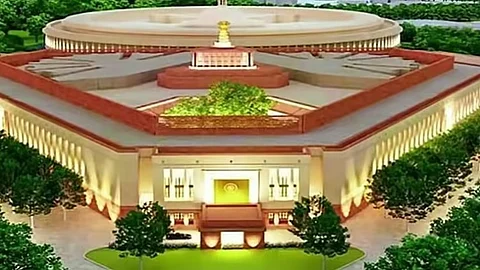

The Union Ministry of Power has issued the “Guidelines for the Installation and Operation of Battery Swapping and Charging Stations,” on January 10, 2025, Shripad Naik, minister of state in the ministry, told the Rajya Sabha. These guidelines outline the standards and protocols to facilitate the development of a nationwide network of battery charging stations and battery swapping stations.
At the start of the Jal Jeevan Mission in August 2019, only 32.3 million (16.7 per cent) rural households were reported to have tap water connections. As of January 30, 2025, states and Union Territories have reported that around 122 million additional rural households have been provided with tap water connections.
As a result, as of January 30, 2025, out of 193.6 million rural households in the country, more than 154.4 million (79.71 percent) have now reported access to tap water, V Somanna, minister of state for Jal Shakti, told the Rajya Sabha.
The Annual Groundwater Quality Report for 2024, prepared by the Central Ground Water Board (CGWB), has identified the presence of contaminants above the prescribed limits for human consumption in isolated pockets of some states and UTs, including Haryana. No new emerging contaminants were identified in the report, Raj Bhushan Choudhary, minister of state for Jal Shakti, told the Rajya Sabha.
Groundwater is a replenishable resource that is naturally recharged every year. CGWB and state nodal/groundwater departments periodically assess the dynamic groundwater resources of each state and UT. This assessment evaluates recharge from rainfall as well as other sources, including tanks, ponds and water conservation structures.
Notably, recharge from these other sources, which includes waterbodies, has increased significantly, rising from 156.08 billion cubic meters (BCM) in 2020 to 175.68 BCM in 2024, Choudhary told the Rajya Sabha.
The Union Ministry of Environment, Forest and Climate Change (MoEFCC) primarily monitors industrial units across the country through the Central Pollution Control Board (CPCB) and State Pollution Control Boards. The annual inspection of grossly polluting industries (GPIs) operating in the main stem states of the Ganga and Yamuna, namely Uttarakhand, Haryana, Delhi, Uttar Pradesh, Bihar, Jharkhand and West Bengal, is carried out by joint teams from third-party technical institutes such as IITs, NITs and State Pollution Control Boards (SPCBs) / Pollution Control Committees.
During 2023, five GPIs in Jharkhand and 132 GPIs in Sonipat Lok Sabha Constituency (129 in Sonipat district, and three in Jind district) were inspected. In Jharkhand, out of five GPIs, two were complying with discharge norms, while three were non-complying, either not meeting discharge standards or lacking valid consent to operate.
All non-complying GPIs were issued show-cause notices by the Jharkhand State Pollution Control Board, which were later withdrawn after the industries complied during subsequent inspections. The estimated discharge from these GPIs was about 523 kiloliters per day, with a pollution load of 5.23 kilogrammes per day in terms of biochemical oxygen demand, Kirti Vardhan Singh, minister of state in the MoEFCC told the Lok Sabha.
MOEFCC notified the Environment Protection (End-of-Life Vehicles) Rules, 2025, on January 6, 2025 for the environmentally sound management of end-of-life vehicles. These rules are based on the principle of extended producer responsibility (EPR), where vehicle producers are assigned mandatory EPR targets for the scrapping of end-of-life vehicles.
The rules cover all types of transport and non-transport vehicles, excluding agricultural tractors, agricultural trailers, combine harvesters and power tillers. Under these rules, producers are mandated to fulfil their obligation of Extended Producer Responsibility for the vehicles they have introduced or will introduce in the domestic market, including those for self-use, to ensure compliance with specified scrapping targets, as explained by Singh told the Lok Sabha.
Under the National Clean Air Programme, Rs 42.69 crore was released to Delhi through the Delhi Pollution Control Committee for 2021-22 to 2023-24, of which Rs 13.56 crore has been utilised. The funds have been used primarily for road dust management (Rs 13.53 crore) and construction and demolition waste management (Rs 0.53 crore).
Regular review meetings are held with Delhi government, neighbouring National Capital Region (NCR) states including Punjab, their agencies, the Commission for Air Quality Management in NCR and Adjoining Areas and the Central Pollution Control Board, Singh told the Lok Sabha.
The United Nations Framework Convention on Climate Change (UNFCCC) and its Paris Agreement do not require financial-year-wise reporting. India adheres to its updated Nationally Determined Contributions (NDC), submitted in 2022, in accordance with the Paris Agreement under the UNFCCC.
According to India’s 4th Biennial Update Report (BUR-4), submitted to the UNFCCC on 30th December 2024, between 2005 and 2020, India’s emission intensity of Gross Domestic Product (GDP) reduced by 36 per cent, compared to the NDC target of a 45 per cent reduction by 2030. Regarding the achievement of the target under the NDC related to the share of non-fossil fuel-based sources, the share in India’s total installed electricity generation capacity stood at 47.10 per cent in December 2024, compared to the 50 per cent target to be achieved by 2030, Singh told the Lok Sabha.